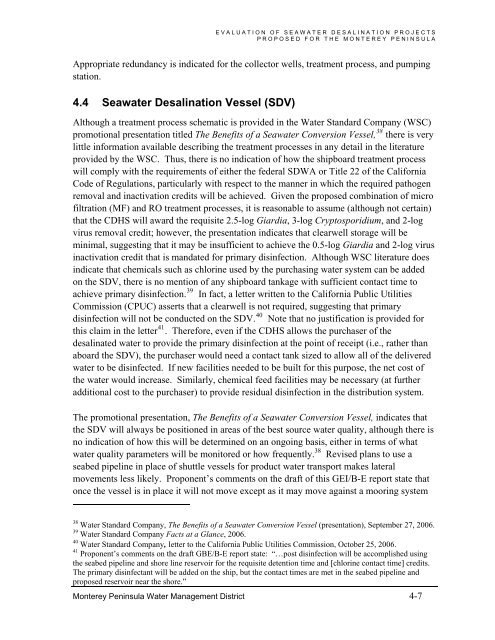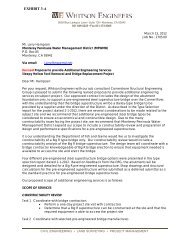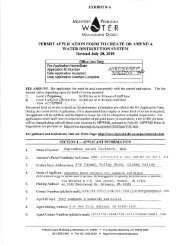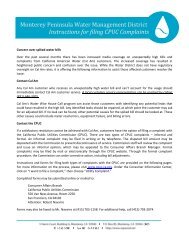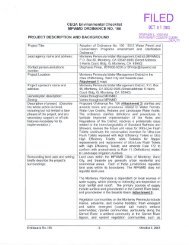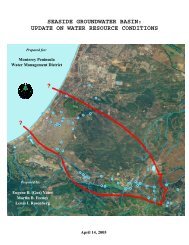FINAL REPORT Evaluation of Seawater Desalination Projects ...
FINAL REPORT Evaluation of Seawater Desalination Projects ...
FINAL REPORT Evaluation of Seawater Desalination Projects ...
You also want an ePaper? Increase the reach of your titles
YUMPU automatically turns print PDFs into web optimized ePapers that Google loves.
EVALUATION OF SEAWATER DESALINATION PROJECTS<br />
PROPOSED FOR THE MONTEREY PENINSULA<br />
Appropriate redundancy is indicated for the collector wells, treatment process, and pumping<br />
station.<br />
4.4 <strong>Seawater</strong> <strong>Desalination</strong> Vessel (SDV)<br />
Although a treatment process schematic is provided in the Water Standard Company (WSC)<br />
promotional presentation titled The Benefits <strong>of</strong> a <strong>Seawater</strong> Conversion Vessel, 38 there is very<br />
little information available describing the treatment processes in any detail in the literature<br />
provided by the WSC. Thus, there is no indication <strong>of</strong> how the shipboard treatment process<br />
will comply with the requirements <strong>of</strong> either the federal SDWA or Title 22 <strong>of</strong> the California<br />
Code <strong>of</strong> Regulations, particularly with respect to the manner in which the required pathogen<br />
removal and inactivation credits will be achieved. Given the proposed combination <strong>of</strong> micro<br />
filtration (MF) and RO treatment processes, it is reasonable to assume (although not certain)<br />
that the CDHS will award the requisite 2.5-log Giardia, 3-log Cryptosporidium, and 2-log<br />
virus removal credit; however, the presentation indicates that clearwell storage will be<br />
minimal, suggesting that it may be insufficient to achieve the 0.5-log Giardia and 2-log virus<br />
inactivation credit that is mandated for primary disinfection. Although WSC literature does<br />
indicate that chemicals such as chlorine used by the purchasing water system can be added<br />
on the SDV, there is no mention <strong>of</strong> any shipboard tankage with sufficient contact time to<br />
achieve primary disinfection. 39 In fact, a letter written to the California Public Utilities<br />
Commission (CPUC) asserts that a clearwell is not required, suggesting that primary<br />
disinfection will not be conducted on the SDV. 40 Note that no justification is provided for<br />
this claim in the letter 41 . Therefore, even if the CDHS allows the purchaser <strong>of</strong> the<br />
desalinated water to provide the primary disinfection at the point <strong>of</strong> receipt (i.e., rather than<br />
aboard the SDV), the purchaser would need a contact tank sized to allow all <strong>of</strong> the delivered<br />
water to be disinfected. If new facilities needed to be built for this purpose, the net cost <strong>of</strong><br />
the water would increase. Similarly, chemical feed facilities may be necessary (at further<br />
additional cost to the purchaser) to provide residual disinfection in the distribution system.<br />
The promotional presentation, The Benefits <strong>of</strong> a <strong>Seawater</strong> Conversion Vessel, indicates that<br />
the SDV will always be positioned in areas <strong>of</strong> the best source water quality, although there is<br />
no indication <strong>of</strong> how this will be determined on an ongoing basis, either in terms <strong>of</strong> what<br />
water quality parameters will be monitored or how frequently. 38 Revised plans to use a<br />
seabed pipeline in place <strong>of</strong> shuttle vessels for product water transport makes lateral<br />
movements less likely. Proponent’s comments on the draft <strong>of</strong> this GEI/B-E report state that<br />
once the vessel is in place it will not move except as it may move against a mooring system<br />
38 Water Standard Company, The Benefits <strong>of</strong> a <strong>Seawater</strong> Conversion Vessel (presentation), September 27, 2006.<br />
39 Water Standard Company Facts at a Glance, 2006.<br />
40 Water Standard Company, letter to the California Public Utilities Commission, October 25, 2006.<br />
41 Proponent’s comments on the draft GBE/B-E report state: “…post disinfection will be accomplished using<br />
the seabed pipeline and shore line reservoir for the requisite detention time and [chlorine contact time] credits.<br />
The primary disinfectant will be added on the ship, but the contact times are met in the seabed pipeline and<br />
proposed reservoir near the shore.”<br />
Monterey Peninsula Water Management District 4-7


